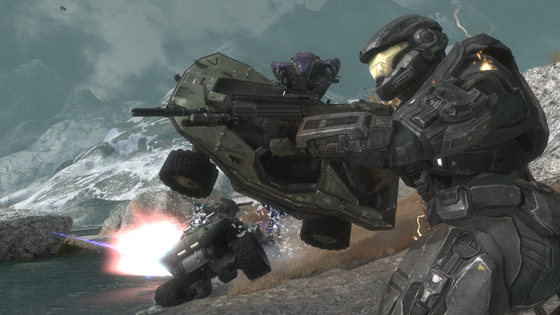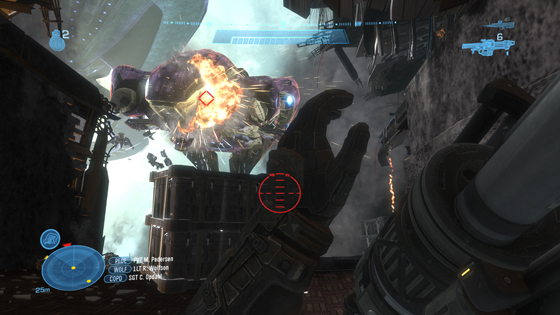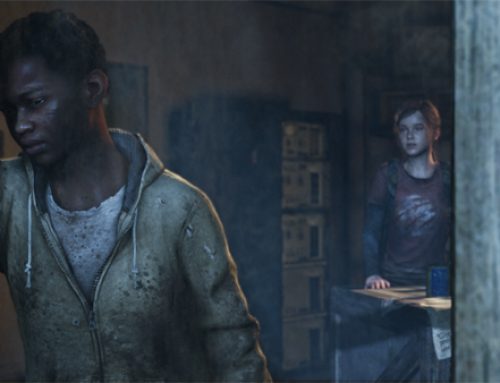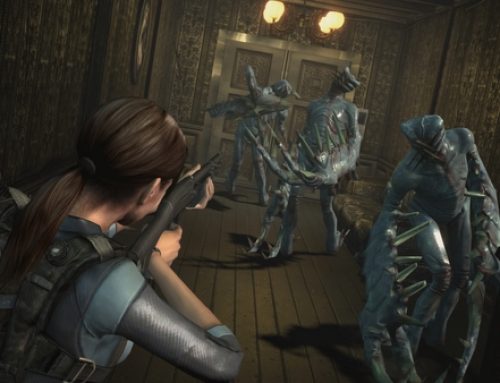
"Halo: Reach" represents original series developer Bungie Studios' farewell to the franchise that made the Xbox a must-own game console.
With “Halo: Reach,” Bungie Studios says goodbye to its megahit franchise by taking the series that put the Xbox on the map to its logical zenith, creating its most finely tuned, feature-packed game to date.
While fans may quibble over which of the four first-person shooters has the best cast of characters and most memorable story, “Reach’s” robust online and community features build on everything Bungie has put into the series, sharpening the formula to a fine point while introducing a few new wrinkles that help the combat evolve.
For the uninitiated, “Halo: Reach” (rated M, $60, $80 or $150 on Xbox 360, depending on edition) serves as a prequel to the original “Halo: Combat Evolved,” released back in 2001. It depicts the fall of the planet Reach, a massive human settlement second only in importance to Earth, to the Covenant, a theocratic coalition of alien races. “Reach” tells the story of a heroic team of Spartans — superhuman soldiers — as they futilely try to beat back an overwhelming enemy, evacuate citizens and engage in behind-the-scenes special ops.
Like last year’s “Halo 3: ODST,” “Reach” leaves Master Chief, the hero of the first three “Halos,” on the bench. Instead, you’ll play as Noble 6, a Spartan whose gender and appearance you customize. Because the option to play the campaign as a female Spartan was new, I made my Spartan a woman when I played through “Reach” at a two-day media preview late last month. While Noble 6 isn’t as chatty as her computer-controlled squadmates, it’s impressive when a developer takes the extra step and includes male and female voices for its player-created hero.
What Noble 6 — who’s still more outspoken than Master Chief — lacks in gregariousness, her squadmates make up for. Each member of Noble Team is infused with a distinctive personality and wears customized armor. These aren’t your older brother’s Spartans, and gamers who’ve become weary of the stoic, cool-to-a-fault Master Chief will find these new characters easier to like. The fact that we know ahead of time that their mission is doomed makes getting to know Carter, Kat, Jorge, Emile and Jun feel bittersweet and, contrary to what you’d expect, gives the story more weight. It’s as if Bungie’s been liberated by not having to make yet another game about saving humanity. By the time the game ends, you’ll be simultaneously grieving lost comrades while wishing Microsoft would hurry the heck up and release current-generation remakes of the first two “Halo” games so we can continue the story without going back to 2001- and 2004-era graphics.
From a gameplay standpoint, “Halo: Reach” handles a lot like past “Halo” titles. The fact that “Reach” is a prequel allows Bungie to do away with some of “Halo 2” and “3’s” more implausible features, such as regenerating health and Master Chief’s ridiculous ability to accurately fire one gun in each hand. (There’s supersoldier, and then there’s superdupersoldier, apparently.) As in “Halo: Combat Evolved,” you’ll be on the lookout for health packs once Noble 6’s shields are brought down and she starts taking damage.
While “Halo 3” introduced equipment — essentially one-shot power-ups that conferred abilities such as active camouflage or portable shields — they’ve been replaced with armor abilities, essentially reusable equipment that requires a cooldown period after each use. Some of them allow the user to sprint, become temporarily invisible or fly through the air with a Boba Fett-like jetpack. Probably the most strategic is armor lock, which sends Spartans into a crouch for a short time and makes them impervious to damage. Get your timing down, and you’ll be owning grenade-spamming noobs like nobody’s business.
Despite the new wrinkles, “Reach” is still undeniably a “Halo” game. Even though Bungie has added a variation of the prestige/experience system that’s become all the rage in multiplayer shooters, you’re bound to feel frustrated at some point at the game’s general lack of a cover system. (As in past “Halo” titles, you can crouch behind environmental objects, but there’s no clinging to doorways or blind firing out of cover, which can make “Reach” feel dated at times.) The big, floaty jumps, powerful melee attacks and sticky grenades are all still present, which means playing “Reach” will either feel like riding your favorite bike or more of that game you abandoned in favor of “Call of Duty,” depending on your viewpoint.
“Halo: Reach’s” most talked about, lasting level may very well be “Long Night of Solace,” which puts Noble 6 inside a nimble spacecraft called the Sabre and tasks her with blasting Covenant ships out of Reach’s orbit. Considering that piloting the Sabre is only one part of one level in a much larger game, “Long Night” feels incredibly polished. The Sabre handles so smoothly, and the aerial dogfights are so satisfying that I’d happily play a “Halo” game devoted entirely to such combat. It’s a pity, then, that “Reach’s” competitive multiplayer modes don’t feature the Sabre. If you want to fly with your friends, you’ll have to play that chapter of the game co-op. We can only hope that part of the downloadable content plans for “Reach” include multiplayer Sabre duels.
Don’t let that last statement trick you into thinking that “Halo: Reach” is lacking on the multiplayer front. All the popular gametypes from past “Halo” titles return, many with additional polish. “Reach” also sports a few new modes, such as the excellent Headhunter, which has players collecting skulls from their victims and racing to return them to a designated area before they, in turn, are killed by another player.
Despite the new additions, as well as a more user-friendly, expanded version of “Halo 3’s” level-editing and video features, the biggest upgrades to “Reach’s” multiplayer are to “Halo 3: ODST’s” popular Firefight mode.
Firefight, which pits a team of Spartans against waves upon waves of computer-controlled Covenant, felt like a trial balloon in “ODST.” It returns as a full-featured component of “Reach’s” multiplayer. Just as they’ve been doing in other modes for the better part of a decade, “Halo” fans will be able to add incredible amounts of customization to Firefight games.
The most fun I had while previewing this game was when another journalist set up a Firefight match with low gravity, extra health, boosted-up shields, insane speeds and infinite ammo. We played on the toughest difficulty setting, flew around like kids and blasted Covenant into oblivion with our rocket launchers, safe in the knowledge that the only thing that could kill us was when our own stupidity sent us jetpacking clear out of the arena.
This combination of stupid fun with the “Halo” franchise’s most emotionally resonant story is what makes “Reach” the greatest “Halo” game. But while “Halo: Reach” is a fantastic way for Bungie to depart before unveiling its next, Activision-published franchise, there’s plenty of opportunity for someone else to come in and take Microsoft’s baby in a bold new direction. It’ll take a brave but talented developer to overhaul the cover system and evolve the combat as the genre continues to mature, all while keeping intact the community features and everything that makes “Halo” great. But unlike the task of saving Reach, it’s not an impossible one.






